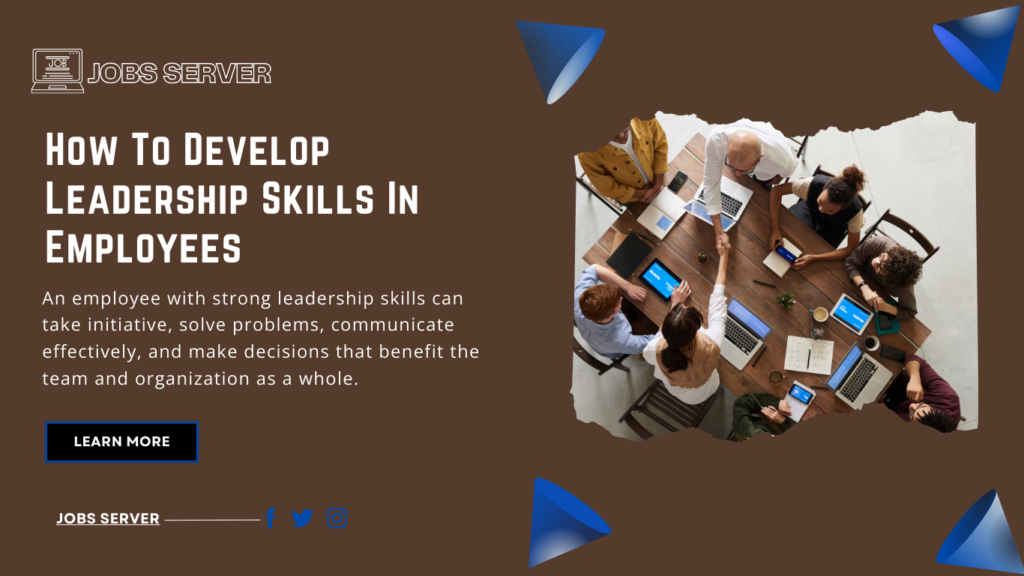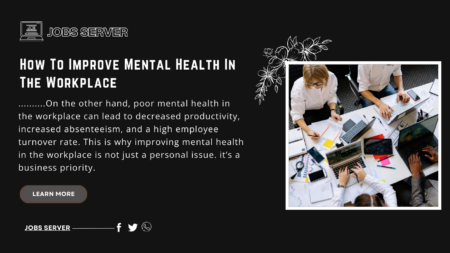HOW TO DEVELOP LEADERSHIP SKILLS IN EMPLOYEES?
INTRODUCTION
In today’s competitive business and working environment, the need for strong leaders within organizations has never been more critical. However, we all know that effective leadership is not just the domain of top executives; it must be cultivated across all levels of a company. So, developing leadership skills in employees is very important for promoting a proactive, innovative, and resilient workforce. But how can organizations successfully nurture these skills, transforming potential into performance? That is what we will be looking at in this article, welcome as we begin.
What Are Leadership Skills In An Employee?
You need to know that leadership skills in an employee go beyond the ability to manage a team or project. leadership skills encompass a range of skills that empower individuals to inspire, guide, and influence others, even if they do not hold formal leadership positions. An employee with strong leadership skills can take initiative, solve problems, communicate effectively, and make decisions that benefit the team and organization as a whole.
Leadership in this context isn’t about titles or authority but rather about behaviors and actions. For example, an employee who steps up to mentor a struggling colleague or who suggests ground-breaking solutions during a meeting is demonstrating leadership. These actions he or she took add to a positive workplace culture and drive organizational success.
EXAMPLES OF ESSENTIAL LEADERSHIP SKILLS AN EMPLOYEE NEEDS TO DEVELOP
Developing leadership in employees involves improving specific skills that are critical to effective leadership. Below I will show some essential leadership skills you need to focus on if you need leadership skill
1. Communication Skill
Good communication is the foundation of leadership. An employee who can send ideas, listen actively, and adapt their communication style to different audiences will always make his way into leadership roles. This includes not just verbal communication but also written and non-verbal cues, such as body language.
They were a time in my previous role as a team lead when I noticed that one of my coworkers struggled to express their ideas in meetings. We worked together to improve their public speaking skills, which not only boosted their confidence but also led to their promotion as a project manager.
2. Emotional Intelligence Skill (EI)
During my time as a team leader, I once had a technically brilliant employee who struggled with team dynamics. Through EI training and coaching I gave them, they learned to manage their reactions better and became one of the most effective team leaders in the department.
Emotional intelligence is the ability to recognize, understand, and manage one’s own emotions, as well as the emotions of others. Employees with high emotional intelligence can help interpersonal relationships and empathy, making them better leaders.
3. Decision-Making Skill
The ability to make informed, timely decisions is a critical leadership skill. Employees who can weigh the pros and cons, consider the impact on the team, and take decisive action are valuable assets to any organization.
I can remember when I had to make quick decisions on resource allocation. By empowering my team to make decisions independently within their areas of expertise. Having the decision-making ability helped us to meet tight deadlines without compromising quality.
4. Adaptability Skill
Leaders must be adaptable in the face of change. An adaptable employee is open to new ideas, can pivot strategies when necessary, and remains calm under pressure. This is vital in today’s rapidly changing business environment.
They were a time when our company was restructuring, and one of my team members emerged as a leader by embracing the changes and helping others adjust. Their adaptability not only eased the transition for the entire team but also earned them a promotion.
5. Conflict Resolution Skill
Leadership often involves navigating conflicts within a team. Employees who can address disagreements constructively, mediate disputes, and find win-win solutions are invaluable to maintaining a positive work environment.
They were a time when I was working with two employees who had a long-standing disagreement. By coaching them on conflict resolution techniques, they learned to work together more effectively, ultimately leading to improved team performance.
6. Visionary Thinking Skill
Visionary thinking is the ability to see the big picture and anticipate future trends. Employees with this skill can align their work with the organization’s long-term goals and inspire others to do the same.
Visionary Thinking, was one of my skills When I was working with two employees, I encouraged my team to think beyond their immediate tasks and consider how their work contributed to the company’s mission. This shift in perspective led to more innovative solutions and a stronger sense of purpose within the team.
WHY LEADERSHIP SKILLS DEVELOPMENT IS IMPORTANT
Developing leadership skills in employees is not just beneficial for the individuals involved; it is crucial for the organization as a whole. Here’s why:
It Enhanced Team Performance In Working Environments
When employees possess leadership skills, they contribute more effectively to their teams. This leads to improved collaboration, higher productivity, and better outcomes. Teams with strong leaders are more likely to meet their goals and exceed expectations.
2. It Increased Innovation In Working Environments
Leadership skills foster a culture of innovation. Employees who are encouraged to take initiative and think creatively are more likely to develop new ideas and solutions. This innovation drives the company forward and keeps it competitive in the marketplace. You can achieve this by creating a “leadership in innovation” program this type of program encourages employees to present new ideas.
3. It Improved Employee Retention
Investing in leadership development shows employees that the company is committed to their growth. This not only enhances their skills but also increases job satisfaction and loyalty, leading to higher retention rates. As a leader, by providing regular leadership training and development opportunities, you can reduce turnover in your department by 20% over two years. Employees will feel valued and will see a clear path for their career progression.
4. It Makes One A Better Decision-Maker
Employees with leadership skills are better equipped to make decisions that align with the company’s values and objectives. This leads to more consistent and effective decision-making across all levels of the organization.
In my organization, I once implemented a decision-making workshop for my team, and I observed a marked improvement in their ability to make sound decisions independently. This independence not only empowered them but also sped up project timelines.
5. Stronger Organizational Culture Skill
Leadership development contributes to a strong organizational culture where values such as trust, respect, and collaboration are prioritized. This creates a positive work environment where employees are motivated to perform at their best.
HOW TO DEVELOP LEADERSHIP SKILLS IN EMPLOYEES?
Developing leadership skills in employees requires a deliberate and structured approach. Below are some strategies to effectively nurture these skills:
- By Providing Leadership Training Programs
Formal training programs are an excellent way to develop leadership skills. These can include workshops, seminars, or online courses that cover essential leadership topics such as communication, decision-making, and emotional intelligence. You need to tailor these programs to address the specific needs of your employees. For instance, if your team struggles with conflict resolution, focus on that area to maximize the impact.
- By Encouraging Mentorship and Coaching
Mentorship and coaching provide employees with personalized guidance and support. Pairing employees with experienced mentors can help them develop leadership skills in a real-world context, offering valuable insights and feedback. For me, I will advise you to create a structured mentorship program where mentors and mentees are matched based on their skills and career goals.
This ensures that the mentorship is effective and beneficial for both parties. During my time as a leader, I found that mentorship was particularly effective in developing leadership skills in junior employees. By pairing them with seasoned leaders, they gained the confidence and expertise needed to take on more significant responsibilities.
- By Offering Opportunities for Leadership Roles
Give employees the chance to step into leadership roles, even on a temporary or project-based basis. This hands-on experience is invaluable for developing their skills and confidence. You can achieve this by assigning leadership roles in small projects, allowing employees to gradually build their skills without feeling overwhelmed.
I was once assigned to manage a product development team, I rotated leadership roles among the team members for different project phases. This approach not only developed their leadership skills but also fostered a sense of ownership and accountability.
- By Adopting a Culture of Feedback
Encourage a culture where constructive feedback is regularly given and received. This helps employees identify areas for improvement and provides them with the guidance needed to enhance their leadership abilities. Implementing regular feedback sessions and encouraging open communication creates a safe space for employees to learn and grow. You can get noticeable improvements in leadership skills and overall performance by instituting monthly feedback sessions where team members can give and receive feedback.
- By Promoting Self-Directed Learning
Encourage employees to take charge of their leadership development by seeking out learning opportunities, such as books, podcasts, and webinars. Self-directed learning empowers employees to explore areas of leadership that interest them most. Also, providing resources and recommendations to guide their learning, and considering setting up a shared platform where employees can discuss what they’ve learned will help them improve
Sometimes I encouraged my team to explore leadership topics on their own and share their insights during team meetings. This not only broadened their knowledge but also sparked discussions that led to innovative ideas.
- By Recognizing and Reward Leadership Efforts
Recognizing and rewarding leadership behaviors reinforces the importance of these skills and motivates employees to continue developing them. Public recognition, promotions, or leadership awards are effective ways to acknowledge their efforts. To achieve this, you need to establish a recognition program that specifically targets leadership development, celebrating both small and significant achievements.
In my organization I implemented a “Leader of the Month” program where employees were recognized for their leadership efforts. This not only motivated them but also created a positive competitive spirit within the team
FINAL THOUGHT
Developing leadership skills in employees is a strategic investment that pays dividends in the form of increased productivity, innovation, and employee satisfaction. By providing the right training, opportunities, and support, organizations can cultivate a workforce of empowered leaders ready to take on challenges and drive
SOME ASKED QUESTIONS ON HOW TO DEVELOP LEADERSHIP SKILLS IN EMPLOYEES
1) How can I identify employees with leadership potential?
- Look for employees who take initiative, communicate well, and show empathy. These individuals often demonstrate problem-solving skills and inspire others, even without a formal leadership role.
2) What are the first steps to developing leadership skills in my team?
- Start by offering leadership training and creating opportunities for employees to lead small projects. Encourage mentorship and provide regular feedback to guide their growth.
3) Why is emotional intelligence important for leadership?
- Emotional intelligence allows leaders to manage their own emotions and understand others. This skill helps in building strong relationships, resolving conflicts, and motivating teams effectively.
4) How can I foster a leadership culture in my organization?
- Promote open communication, encourage continuous learning, and recognize leadership behaviors. Create an environment where leadership is valued and cultivated at all levels.
5) What role does feedback play in leadership development?
- Feedback is crucial for growth. It helps employees understand their strengths and areas for improvement, enabling them to refine their leadership skills and enhance their effectiveness.
6) How can I measure the success of leadership development programs?
- Track progress through employee performance reviews, team productivity, and engagement levels. Also, gather feedback from participants to refine and improve the programs over time.
7) What are the benefits of developing leadership skills in employees?
- Developing leadership skills leads to better decision-making, increased innovation, higher employee retention, and a stronger organizational culture.
8) Can leadership skills be taught or are they innate?
- Leadership skills can be developed through training, experience, and mentorship. While some individuals may have natural tendencies, most leadership abilities can be learned and refined
9) How do I encourage employees to take on leadership roles?
- Create opportunities for them to lead, offer support, and provide recognition for their efforts. Make leadership development a clear path for career progression in your organization.
10) What challenges might I face when developing leadership skills in employees?
Resistance to change, lack of confidence, and limited leadership opportunities can be challenges. Overcome these by offering continuous support, tailored training, and clear communication





